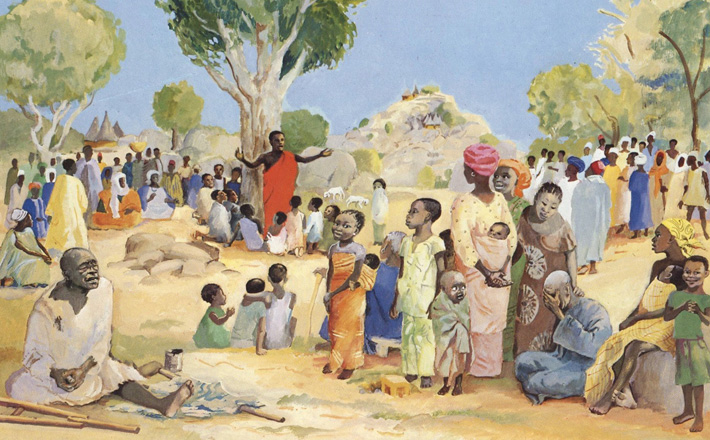Commentary on Matthew 5:1-12
The chance to preach four Sundays in a row on the Sermon on the Mount may seem to be less an opportunity and more like a burden.
Not unlike the five weeks assigned to the Bread of Life Discourse from John in the season of Pentecost in Year B, this opening speech of Jesus in Matthew might cause the preacher to wonder if what Jesus has to say in this passage is really different each week. Perhaps a step back might offer some perspective.
First things
This is Jesus’ first public act in the book of Matthew. It is worth comparing each of these events in the Gospels because they give us a clue as to both the Christological portrait at stake for that individual writer. That Jesus performs an exorcism in Mark as his inaugural act suggests Mark sees Jesus as the ultimate boundary crosser. Indeed, God tears apart the boundaries that separated God from God’s people, first at Jesus’ baptism and then at Jesus’ crucifixion. That which keeps us apart from God, or, depending on your theology, keeps God at bay is ripped from top to bottom. You either like this God or you don’t, depending on who you need or want God to be.
In Luke, Jesus returns to his hometown of Nazareth and preaches a sermon—every intern’s worst nightmare. The sermon is a summary of his what his ministry will be—and for whom. For Luke, Jesus is the savior of the marginalized, the outcast, the unseen. The rejection at Nazareth calls out our unwillingness to imagine God might be for someone other than ourselves. The desire to cast Jesus off a cliff foreshadows the refutation of the disciples by the announcement of the empty tomb as proclaimed by the women. We are just fine with a savior for us but not so much with a savior for those we despise.
In John, the wedding at Cana is a sign of abundance. Turning water into wine, as miraculous as that is, is not really the point. The point is just how much: six jars, twenty-to-thirty gallons each, filled to the brim of the best wine when you least expect. It is a manifestation, an incarnation, if you will, of grace upon grace. That is indeed who Jesus is for John—the very presence of God’s abundant grace.
Which then brings us to Matthew. Who is Jesus for Matthew? The teacher of all righteousness. And whom does he teach? His disciples. This means teaching is important. This means being a disciple is to be the consummate student, a learner. Being a disciple in Matthew demands that our first act of discipleship is to recognize Jesus as teacher.
So, before we get too far into the what of the Sermon on the Mount, it is important to ask about the why—why a sermon, why teaching, why here and now, and why first to the disciples? Answering these questions will direct this first attempt at a sermon on the Sermon on the Mount toward how it might have been experienced by Jesus’ first disciples. Then, you are not just preaching about the Sermon on the Mount, but letting it preach itself. This is one of the oft-unnamed difficulties of this portion of Matthew’s Gospel—you are preaching a sermon on a sermon. The first thing the preacher should do is consider how to let the sermon preach itself rather than explain its potency away.
The purpose of preaching
Sermons are not just content but are intent on creating an experience. Something should happen, and that something should not just be communicating words. What do you think Jesus wanted to have happen with this sermon? What did he want the disciples to experience? So, for each section these next four weeks, attempt to answer this question. What do the Beatitudes do? They don’t just remind the disciples that they are blessed. Jesus wants them to feel that they are blessed.
Why is teaching so important for Jesus? Or, for that matter, why is learning so critical for a life of faith? It’s important to remember that who Jesus is simultaneously reveals who we are. For Matthew, the disciples are students, learners. But that learning cannot happen outside of the realm of promise. You are blessed. You are the light of the world. You are the salt of the earth. Only with these claims of identity in place can the disciples, can we, live out what Jesus will ask us to do.
The Beatitudes are identifiers of discipleship; characteristics of the faithful; attributes of believers. They are truth-tellings. They name our blessings but also what is at stake in these blessings. This is why this sermon has to be preached here and now to the disciples and not later. They have to know who they are in order to be able hear the rest of what Jesus has to say about who he needs them to be. This first sermon has to be delivered to them so that the Great Commission might actually come to fruition.
Being blessed
You are blessed. You have to hear that on the front end. And note that being blessed is not just for the sake of potential joy, but also for the sake of making it through that which will be difficult. Again, these are Jesus’ first words to his disciples. We need to hear in each and every one of the Beatitudes what’s at stake for Jesus and for his ministry.
It’s worth remembering as a preacher that these are texts heard in the season of Epiphany. What difference does that make for preaching them? Going forward, here are potential stages of this section from Matthew—possible phases of manifestation, if you will.
- Matthew 5:1-12 Who are the Disciples
- Matthew 5:13-20 The Responsibilities of Discipleship
- Matthew 5:21-37 Discipleship in Community
- Matthew 5:38-48 Discipleship in the World
Why stages? Well, to some extent this is at the heart of Epiphany. What is revealed is revealed in its time. A preacher’s job is to tend such revelation.


January 29, 2017